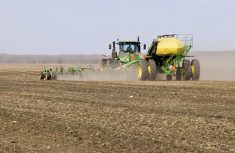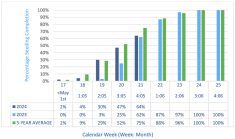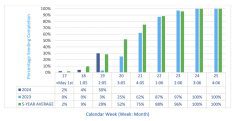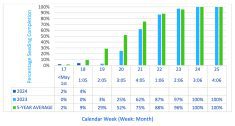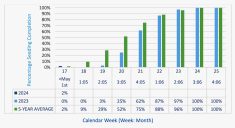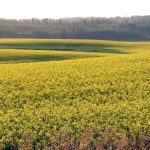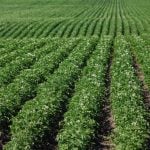Overview
Harvest progress sits at 79 per cent completed across the province, approximately two weeks behind the 5-year average of 89 per cent complete by week 41.
Canola continues to be harvested in all regions, but notable progress has been made in the Southwest region, where crops were generally later and more variable than other regions. Harvest progress sits at 63 per cent complete in the Southwest and at 79 per cent done across Manitoba.
Read Also

Squid fertilizer draws interest at Ag In Motion
GreenFlow says its Squid Juice might elicit a smile or chuckle, but insists the fertilizer and its benefits are for real.
Soybean harvest has jumped up to 50 per cent complete, and producers have been pleased with yields so far this year, which range from 30 to over 60 bu/acre, generally averaging above 40 bu/acre.
As with spring seeding, harvest progress varies widely by farm and region, depending on seeding date and growing season weather conditions. Many farms have completed harvest, while some have just started.
Some unharvested cereals have seen quality downgrading from recent wet weather, where staining, mildew and sprouting has affected late wheat and oat crops.
Fall tillage and fieldwork is underway wherever farmers are caught up with harvest, or are able to work when rains stops harvest progress. Erasing sprayer ruts via tillage is common, and fields are being worked more commonly than in the previous two years.
Fertilizer application is ongoing, with some broadcast fertilizer being applied, while many farms choose to band granular nitrogen or anhydrous ammonia.
Cereals
Spring cereal grains
Better drying weather in recent days has allowed cereal harvest to finally wrap up.
Some wheat crops harvested after the rains have been downgraded to No 3 CWRS as a result of mildew and sprouting, while most remains a No 2 CWRS.
Wheat yields range from 60 to 90 bu/acre in the Northwest, late-seeded crops yielding less.
In oats, growers are making the decision to swath late fields and are dealing with increased shelling losses.
Oats lying in swath for several weeks have stained, some sprouting is occurring, but grain remains
marketable.
Corn
Corn is drying down after killing frosts last week, early harvested fields range from 20 to 25 per cent moisture.
Harvest has started on limited acres in the Red River Valley, no yields reported to date. Farms are
harvesting earlier hybrids in an effort to meet October delivery contracts.
A few corn fields in the northern parts of the Eastern region did see some yield penalty from frost terminating the crop before reaching full maturity.
Oilseeds
Canola
Canola crops are drying slowly following wet weather, and many crops recently harvested are tough (11 to 13 per cent moisture), and require supplemental drying or aeration.
Average yields vary, with a 20 to 60 bu/acre spread across much of the province. Producers have been a little disappointed in canola overall, but yields are still much better than they were in 2021.
Yields in the Northwest region are averaging 55 bu/acre at The Pas, and variable across the rest of the region between 25 to 50 bu/acre.
Flax & sunflowers
Most flax crops are harvested in the Eastern and Central regions, but no yields reported to date.
Sunflowers are drying down; harvest will begin later this week. Yields are expected to be average, given some early drowned-out and later drought-affected spots.
Blackbirds are becoming a pest on ripe sunflower crops, farms are hoping to start harvest as soon as logistics and weather allow.
Pulses
Soybeans
Soybean harvest rapidly advanced last week, with sunny and dry days allowing combines to move quickly on dry fields.
Early-seeded crops in the Southwest appear to have better yields than later crops, while in the Central region, longer-season varieties are yielding better.
The Central and Eastern regions are over 60 per cent complete, and about a third done in the Southwest.
Early-season soybeans were yielding between 40 to 50 bu/acre, while long-season soybeans were
yielding 50 to 65 bu/acre, both with good crop quality.
Soybean yields vary widely in the Northwest, from 20 to 60 bu/acre, with approximately half the crop harvested there.
Dry edible beans
Dry bean harvest is approaching 90 per cent complete. Very good yields reported, with many bean classes yielding between 2,000 to 3,000 lbs/acre.
Forages & livestock
Forages
Grass hay and alfalfa has become dormant. Pastures generally have enough fodder to allow animals to graze for a short time longer, but some are starting to run short of forage and are being supplemented.
Corn silage harvest is done, and recent frosts have caused some silage-intended corn fields to dry down
too rapidly for silage, and will be harvested for grain instead. Yields range from 14 to 18 tonnes/acre.
Farmers are contemplating how to best manage late greenfeed crops still on the field.
Retrieval and removal of hay and straw bales is underway.
Cattle producers have an adequate to a surplus supply of hay and greenfeed. Approximately 75% have an adequate supply of straw, while the remainder are short.
Livestock
Dugouts and sloughs are at 50 per cent capacity in the Southwest, and remain sufficient elsewhere in the province.
Livestock water supplies on pasture are dropping, but remain sufficient to complete the grazing season in all parts of the province.
Fall cattle roundup from community pastures has begun; mostly yearlings and earlier calves are moving to the auction marts at this time.
Some cattle remain on pasture, others have been moved to stubble grazing or extended grazing on cut hayfields.
Regional comments
Southwest
Hard frosts closed out the growing season in the Southwest, with overnight lows dropping to -10 C in a few areas. Producers were still having problems with crops not drying down, or reabsorbing moisture quickly from the air. Green straw was still a problem, limiting harvest time to daylight hours. Some producers have started applying fertilizer and fall herbicides.
Northwest
A killing frost last week closed out the growing season in the region, with temperatures dropping as low as -10 C at Ruthenia. Little to no precipitation fell, so harvest was able to progress. Spring wheat harvest is nearing completion in the region, as is canola. Straw baling seems to be wrapping up, and straw yield has been high. Soybean harvest is approximately half done. Post-harvest fieldwork and anhydrous ammonia application is underway in the Swan Valley region, manure application is ongoing near Roblin. Rain is needed to replenish soil moisture levels for forage stands, and help recharge livestock water supplies for winter.
Central
Frost has helped dry down remaining unharvested crop, with the last of the cereals and canola coming off this week. A big push in soybeans has seen most of that crop harvested, and corn growers have just started or will start harvesting corn this week. Warmer and windy days have helped with field activities, and fall tillage and fertilizer application is underway wherever possible. Most producers are hoping for a warm, open fall to allow for extended fieldwork to be completed, since most of the focus has been on harvest to this point.
Eastern
Repeated overnight frosts arrived in the region last week, terminating the growing season. Significant progress in harvest, haying and fieldwork this past week, including fertilizer application. Short harvesting days are limiting the number of acres that can be harvested in a day, and aeration systems and grain dryers are being used whenever appropriate to allow harvest to continue and condition grain for safe storage. A poor five-day forecast will limit harvest activity this week.
Interlake
Good harvest progress continued last week, with many crops harvested tough – wheat between 16 to 20 per cent moisture and canola between 11 to 12.5 per cent. Farmers are using natural aeration and supplemental grain drying to condition grain to safe storage levels. Last week’s killing frost made green crops easier to harvest, but some oats and flax crops still have green straw, making threshing a challenge. Limited post-harvest weed control has taken place due to late harvested crops and limited new weed growth.







